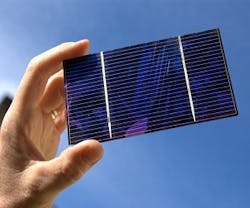New Type of Solar Cell Retains High Efficiency
Scientists from the University of Picardie Jules Verne and the Swiss Federal Institute of Technology are reporting development of a new genre of an electrolyte system for solar cells that breaks the double-digit barrier in the efficiency with which the devices convert sunlight into electricity. This study appears in Journal of the American Chemical Society.
Frederic Sauvage, Michael Graetzel and colleagues describe research aimed to develop an improved version of a highly promising solar cell that is less expensive than conventional solar cells made from silicon. These so-called dye-sensitized solar cells (DSCs), or Graetzel cells (named for the discoverer, Michael Graetzel), have other advantages - They can be manufactured in light-weight flexible sheets, for instance, that are more durable and suitable for roll-up applications such as window shades.
Hindering commercial use of DSCs has been their lack of stability, with the electricity output tending to decline over time.
The new study reports development and successful lab tests of a new electrolyte composition suitable for the DSC, constructed with different material that is both stable and has a relatively high efficiency of 10 percent. It has an improved electrolyte system, the substance that conducted electricity inside the solar cell. The new device retained at least 95 percent of that sun-converting ability for 1,000 hours of testing.
